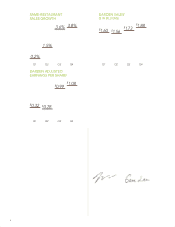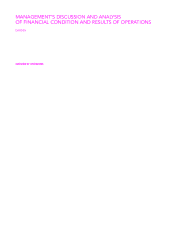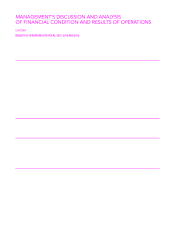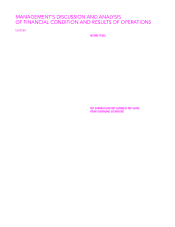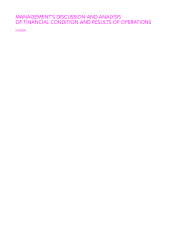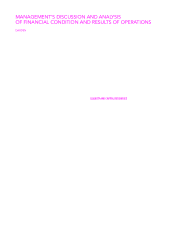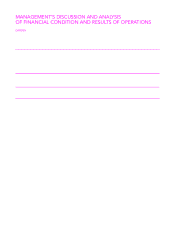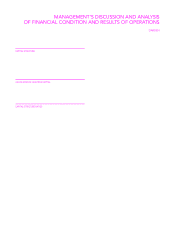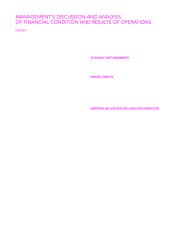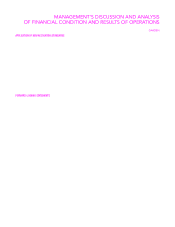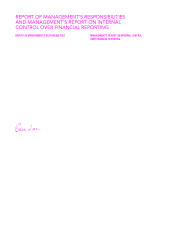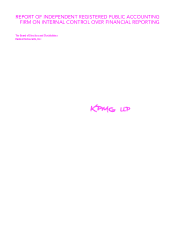Red Lobster 2015 Annual Report Download - page 20
Download and view the complete annual report
Please find page 20 of the 2015 Red Lobster annual report below. You can navigate through the pages in the report by either clicking on the pages listed below, or by using the keyword search tool below to find specific information within the annual report.
16
MANAGEMENT’S DISCUSSION AND ANALYSIS
OF FINANCIAL CONDITION AND RESULTS OF OPERATIONS
DARDEN
and require payment of property taxes, insurance and maintenance costs in
addition to the rent payments. The consolidated financial statements reflect
the same lease term for amortizing leasehold improvements as we use to
determine capital versus operating lease classifications and in calculating
straight-line rent expense for each restaurant. Percentage rent expense is
generally based upon sales levels and is accrued when we determine that it
is probable that such sales levels will be achieved. Landlord allowances are
recorded based on contractual terms and are included in accounts receivable,
net and as a deferred rent liability and amortized as a reduction of rent
expense on a straight-line basis over the expected lease term.
Our judgments related to the probable term for each restaurant affect
the classification and accounting for leases as capital versus operating, the
rent holidays and escalation in payments that are included in the calculation
of straight-line rent and the term over which leasehold improvements for each
restaurant facility are amortized. These judgments may produce materially
different amounts of depreciation, amortization and rent expense than would
be reported if different assumed lease terms were used.
Impairment or Disposal of Long-Lived Assets
Land, buildings and equipment and certain other assets, including definite-lived
intangible assets, are reviewed for impairment whenever events or changes
in circumstances indicate that the carrying amount of an asset may not be
recoverable. Recoverability of assets to be held and used is measured by a
comparison of the carrying amount of the assets to the future undiscounted
net cash flows expected to be generated by the assets. Identifiable cash flows
are measured at the lowest level for which they are largely independent of the
cash flows of other groups of assets and liabilities, generally at the restaurant
level. If these assets are determined to be impaired, the amount of impairment
recognized is measured by the amount by which the carrying amount of the
assets exceeds their fair value. Fair value is generally determined by appraisals
or sales prices of comparable assets. Restaurant sites and certain other assets
to be disposed of are reported at the lower of their carrying amount or fair
value, less estimated costs to sell. Restaurant sites and certain other assets
to be disposed of are included in assets held for sale when certain criteria are
met. These criteria include the requirement that the likelihood of disposing
of these assets within one year is probable. Assets whose disposal is not
probable within one year remain in land, buildings and equipment until their
disposal within one year is probable. Disposals of assets that have a major
effect on our operations and financial results or that represent a strategic shift
in our operating businesses are reviewed to determine whether those assets
would also meet the requirements to be reported as discontinued operations.
We account for exit or disposal activities, including restaurant closures,
in accordance with Financial Accounting Standards Board (FASB) Accounting
Standards Codification (ASC) Topic 420, Exit or Disposal Cost Obligations.
Such costs include the cost of disposing of the assets as well as other facility-
related expenses from previously closed restaurants. These costs are generally
expensed as incurred. Additionally, at the date we cease using a property
under an operating lease, we record a liability for the net present value of
any remaining lease obligations, net of estimated sublease income. Any
subsequent adjustments to that liability as a result of lease termination
or changes in estimates of sublease income are recorded in the period
incurred. Upon disposal of the assets, primarily land, associated with a
closed restaurant, any gain or loss is recorded in the same caption within
our consolidated statements of earnings as the original impairment.
The judgments we make related to the expected useful lives of long-lived
assets and our ability to realize undiscounted cash flows in excess of the
carrying amounts of these assets are affected by factors such as the ongoing
maintenance and improvements of the assets, changes in economic conditions,
changes in usage or operating performance, desirability of the restaurant
sites and other factors, such as our ability to sell our assets held for sale.
As we assess the ongoing expected cash flows and carrying amounts of our
long-lived assets, significant adverse changes in these factors could cause us
to realize a material impairment loss. During fiscal 2015, 2014 and 2013 we
recognized long-lived asset impairment and disposal charges of $62.1 million
($40.3 million net of tax), $16.4 million ($10.1 million net of tax) and $0.9 million
($0.6 million net of tax), respectively. Impairment charges resulted primarily
from the carrying value of restaurant assets exceeding the estimated fair
market value, which is based on projected cash flows. These costs are included
in impairments and disposal of assets, net as a component of earnings from
continuing operations in the accompanying consolidated statements of earnings
for fiscal 2015, 2014 and 2013. Impairment charges were measured based
on the amount by which the carrying amount of these assets exceeded their
fair value.
Valuation and Recoverability of Goodwill and Trademarks
We review our goodwill and trademarks for impairment annually, as of the first
day of our fiscal fourth quarter, or more frequently if indicators of impairment
exist. Goodwill and trademarks are not subject to amortization and have been
assigned to reporting units for purposes of impairment testing. The reporting
units are our restaurant brands. At May 31, 2015 and May 25, 2014, we had
goodwill of $872.4 million and $872.5 million, respectively. We had trademarks
of $574.6 million at May 31, 2015 and May 25, 2014.
A significant amount of judgment is involved in determining if an indicator
of impairment has occurred. Such indicators may include, among others: a
significant decline in our expected future cash flows; a sustained, significant
decline in our stock price and market capitalization; a significant adverse
change in legal factors or in the business climate; unanticipated competition;
the testing for recoverability of a significant asset group within a reporting unit;
and slower growth rates. Any adverse change in these factors could have
a significant impact on the recoverability of these assets and could have a
material impact on our consolidated financial statements.
The goodwill impairment test involves a two-step process. The first step
is a comparison of each reporting unit’s fair value to its carrying value. We
estimate fair value using the best information available, including market
information and discounted cash flow projections (also referred to as the
income approach). The income approach uses a reporting unit’s projection
of estimated operating results and cash flows that is discounted using a
weighted-average cost of capital that reflects current market conditions.
The projection uses management’s best estimates of economic and market
conditions over the projected period including growth rates in sales, costs and
number of units, estimates of future expected changes in operating margins
and cash expenditures. Other significant estimates and assumptions include
terminal value growth rates, future estimates of capital expenditures and
changes in future working capital requirements. We validate our estimates
of fair value under the income approach by comparing the values to fair value
estimates using a market approach. A market approach estimates fair value
by applying cash flow and sales multiples to the reporting unit’s operating
performance. The multiples are derived from comparable publicly traded
companies with similar operating and investment characteristics of the
reporting units.


